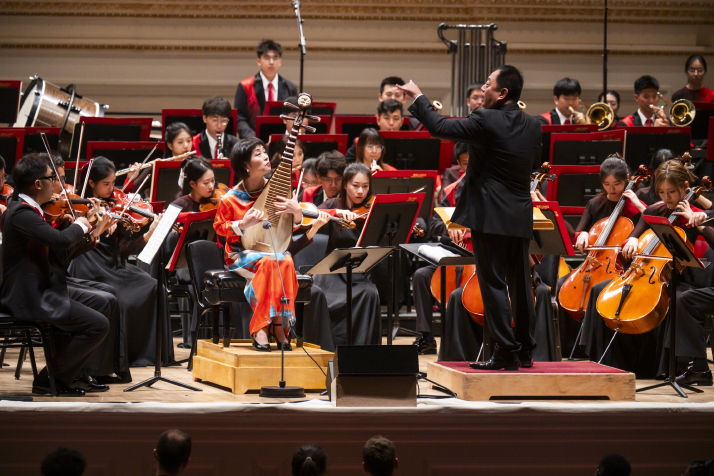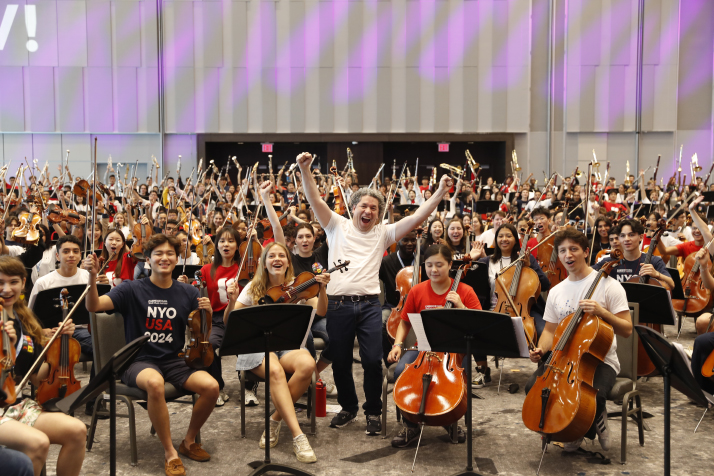| World |
| Young Chinese musicians wow New York City | |
|
|
 The Beijing Youth Orchestra, led by conductor Lu Jia, performs with Wu Man, a virtuoso of the pipa, a traditional Chinese stringed instrument, at Carnegie Hall's inaugural World Orchestra Week (WOW!) in New York City on August 4 (CHRIS LEE)
While the world was still looking to Paris for Olympic glory in early August, New York City orchestrated its own symphony of cultural exchange. In the heart of Manhattan, the renowned Carnegie Hall raised the curtain on World Orchestra Week (WOW!), a melodious celebration of international communication that rivaled the grandeur of any sporting spectacle. From August 1 to 7, seven young orchestras from different parts of the world transformed this world-renowned stage into a global crossroads of harmony. Among them was the Beijing Youth Orchestra (BYO), weaving Eastern artistry into the fabric of Western classics. From campus to stage "I really hoped I would have the opportunity to perform at Carnegie Hall. It's probably the most amazing concert hall in the world. I'm excited about meeting other young musicians from different countries. It will be wonderful to share our love of music," Cui Bingxuan, a 14-year-old violinist from the High School Affiliated to Renmin University of China (RDFZ), told Beijing Review on July 19 during a group interview in Beijing. Including Cui, the BYO comprises 130 talented young musicians aged 14 to 24 from the Central Conservatory of Music, Beijing No.101 Middle School and RDFZ. Founded in June by the National Center for the Performing Arts (NCPA) in Beijing and the Beijing Municipal Education Commission, BYO is the country's first official youth symphony orchestra. The new orchestra made its domestic debut at the NCPA on July 26. Lu Jia, artistic director of music at the center and the principal conductor of the NCPA Orchestra, also serves as artistic director of the BYO and conducted the young orchestra's performances in New York City. In the interview on July 19, Lu emphasized the significance of BYO's international debut, calling it "a very important historical moment and a remarkable beginning." He added, "Through experiencing music and working together, we can stimulate kids' emotions and imaginations while fostering a deeper appreciation for life's charm. This applies to young people not only across China but around the world." According to Lu, despite these young musicians having studied their instruments for many years and being the best in their respective school orchestras, they still need to form a cohesive symphony orchestra and familiarize themselves with new musical scores. To address this, the NCPA has provided intensive and systematic training for these talented youth. Top professional musicians from the NCPA have offered one-on-one guidance to the young performers, working closely with them on their individual parts before progressing to ensemble practice. In the interview, Li Zhe, concertmaster of the NCPA Symphony Orchestra and artistic consultant for the BYO, emphasized that a symphony orchestra is a collaborative endeavor. "It's a group activity, it's what we truly call teamwork," he stated. Li stressed that long-term cooperation is necessary for developing a tacit understanding and a unique musical style. For BYO, however, the primary challenge lies in its temporary nature. "For this kind of temporary assembly of orchestras, especially youth orchestras, the biggest challenge is that they haven't played together before," Li pointed out. Consequently, they need to establish mutual rapport in a very short time. Despite these challenges, Li expressed his confidence in the youth orchestra's potential. He referred to the members as "having the vitality of youth and a boundless love for music." Li also highlighted the significance of performing in New York City, noting that it had provided additional motivation for the young musicians. He metaphorically described this motivation as "like getting a booster shot," enabling them to establish that much-needed rapport—within a short period. Despite BYO's recent establishment just over a month ago, Lu was optimistic about the orchestra's future prospects. "We are actively planning ahead, focusing on elevating the BYO's reputation and broadening its public recognition. Simultaneously, we are committed to enhancing our skills and pursuing a more professional direction in our development," Lu elaborated.  More than 700 musicians from different parts of the world, including the Beijing Youth Orchestra, perform under Gustavo Dudamel at New York City's Javits Center on August 5 (COURTESY PHOTO)
Musical connections WOW! was Carnegie Hall's first week-long international music event centered on youth symphony orchestras, featuring over 700 international orchestra members. The BYO's establishment coincides with the 45th anniversary of Sino-U.S. diplomatic relations this year, symbolizing the friendship and cooperation between two prominent performing arts institutions: China's NCPA and the U.S.' Carnegie Hall. The BYO, in collaboration with Wu Man, an acclaimed virtuoso of the pipa, a traditional Chinese stringed musical instrument, delivered a captivating performance inside Carnegie Hall's Stern Auditorium on August 4. The program featured excerpts from Chinese Sights and Sounds by renowned Chinese composer and music educator Bao Yuankai, and Pipa Concerto No.2 by Zhao Jiping, the celebrated film composer known for scoring Chinese hits like Raise the Red Lantern and Farewell My Concubine. This eclectic repertoire beautifully showcased traditional Chinese instruments, such as the pipa and the bamboo flute, in harmony with the full orchestra. The performance drew a near-capacity crowd to the prestigious 2,500-seat auditorium, highlighting the cross-cultural appeal of this musical fusion. Young musicians take great pride in presenting traditional Chinese music through the medium of symphony. Wei Yitong, a percussionist in the BYO, shared her thoughts during the interview in Beijing. "Chinese musical compositions contain many distinctive elements, such as Sanban, an ad libitum style rhythm rarely found in Western music. Sanban allows soloists or performers to interpret freely according to their internal rhythm. I believe presenting this unique Sanban performance on the Carnegie Hall stage will really resonate with Western audiences." The second half of the concert featured Russian composer Tchaikovsky's Symphony No.5, a demanding four-movement masterpiece that highlighted the young musicians' skill and energy. Lu's masterful direction melded seamlessly with the orchestra's passion, resulting in a rendition that captivated the audience. The crowd's enthusiasm was evident in the prolonged applause, prompting the orchestra to deliver two encores. In a post-performance interview on August 4, Clive Gillinson, executive and artistic director at Carnegie Hall, expressed interest in potentially making WOW! an annual event hosted in different countries, including China. He emphasized that music can connect people globally, noting that even if these young musicians may eventually pursue different career paths, they might still become leaders in a range of fields, fostering future international exchange and understanding. (Print Edition Title: A Symphony of Cultures) Copyedited by Elsbeth van Paridon Comments to zhaowei@cicgamericas.com |
|
||
|
||||||||||||||||||||||||||||
|